Contents
In his PopMatters article “Fearing God, Fearing the Body: The Theology of ‘The Binding of Isaac’”, G. Christopher Williams discusses various aspects of Edmund McMillen and Florian Himsl’s ingenious (and mildly blasphemous) Zelda/Roguelike hybrid, The Binding of Isaac. Although his reading of the game astutely homes in on the “meatier” parts of Isaac - that is, the implications of the game’s loathsome representation of the corporeal -, I do nevertheless want to point out some omissions in Williams’ treatment of the game.
The article in question is altogether complete in its own right, but also lacking in discussion of the themes, concepts and terms that are nevertheless utilized in the analysis. In this way, I shall be focusing on the things that are left unsaid (intentionally or unintentionally) in Williams’ story. In my complementary article below, I will attempt to shed lots and lots of extra light on what I perceive to be these omissions, which include the genre of body horror, the grotesque, Freud’s conception of the uncanny, as well as the concepts of abjection and the abject.
Isaac, Body Horror and Abjection
Williams’ characterization of the game (emphasis mine), that “…the whole horrific nightmare world that Isaac explores is just a series of grotesque body horrors”1 is a sentence filled to the brim with meaning, and a supreme starting point for any article on The Binding of Isaac.
The game is indeed that, but I beg to differ - even if bordering dangerously on semantics schemantics - that The Binding of Isaac is in no way just a series of “grotesque body horrors”1. Although Williams brings up here both the concepts of the grotesque as well as body horror in one fell swoop, he manages to discuss nor define neither, even though they function to contextualize the game for us by association.
 Body horror, for instance, is reduced simply to “headless corpses, disembodied heads, flies and maggots gathered around excrement”1 and so forth. Which is fair enough; merely paying attention to the fact that many of the monsters bear resemblance or associations to human beings is an excellent starting point.
Body horror, for instance, is reduced simply to “headless corpses, disembodied heads, flies and maggots gathered around excrement”1 and so forth. Which is fair enough; merely paying attention to the fact that many of the monsters bear resemblance or associations to human beings is an excellent starting point.
Nevertheless, a broader connection between McMillen’s admittedly zany gallery of monsters and the actual genre of body horror could have been made. Readers are surely familiar with such exemplary filmic renditions of the genre such as Rosemary’s Baby, The Exorcist, or Alien (or say, Species, mwah!). In essence, vagina with teeth, impossibly distorted bodies, giving birth to something less (or more?) than human. This proposition, of the body and the self as both unfamiliar and dangerous, has always struck fear in the hearts of men. Joseph Cambell, according to Barbara Creed, found
a motif occurring in certain primitive mythologies, as well as in modern surrealist painting and neurotic dream, which is known to folklore as ‘the toothed vagina’ - the vagina that castrates2.
The classic Alien films, for instance, utilize the xenomorph in the development of suspense not only in external, but also in (body-)internal terms. Creed, in her article “Horror and the Monstrous-Feminine: An Imaginary Abjection” (1986), analyses the original Alien film in this manner.
Abjection, popularized primarily by the regrettably incomprehensible Julia Kristeva, is the no-man’s land between the subject and the object; the space between being the self and the other. Creed’s reading of Kristeva, for instance, focuses on abjection as it is produced by society, both culturally and symbolically, in the formation of the border “between human and inhuman”, “between normal and abnormal.”3
Though Creed utilizes Kristeva solely as a tool for the discussion of the feminine, its broader uses are obviously manifold. Creed herself points out that “The abject can be experienced in various ways - one of which relates to biological bodily functions, the other of which has been inscribed in a symbolic (religious) economy”4. The former is plain as day in the context of The Binding of Isaac: “vomit or menstrual blood or shit”, like Williams blurts it. The latter would include, for instance, “dietary prohibitions”4, which are central not only to Catholicism - both the source and target, subject and object, of McMillen’s critique - but Abrahamic religions on the whole. Just take lent. More on this later.
To summarize, one could say that the concept of abjection is vital, even crucial to horror, and startlingly many classic horror movies are based solely on the idea that something dear, beloved and familiar becomes unfamiliar, hostile, or even dangerous. The Binding of Isaac, for instance, utilizes this formula down to a tee: The mother becomes monster-like both in the Genesis 22 -influenced frame story as well as the game’s diegesis (that is, as its boss monster). Indeed, Creed would be more than delighted to see how McMillen utilizes the concepts of motherhood and the maternal - after all, more than a third of her paper deals explicitly with the abjection of the mother figure.
The Uncanny Abject
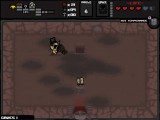
Williams also mentions, in the first sentence quoted above, the concept of the grotesque. Before discussing this, however, I would also like to briefly segue into Sigmund Freud’s original definition of the uncanny, Das Unheimlich, or, “…that class of the terrifying which leads back to something long known to us, once very familiar.”5
Obviously, I’m not citing Freud as any sort of a psychological authority - which he isn’t - but rather a reader and connoisseur of fictions. To this day, his conception of the uncanny is still very much in agreement with our experience of horror as much as it is in accord with the idea of abjection. Indeed, a mother turning unfamiliar on his son is a perfect representation of both concepts.

In the context of The Binding of Isaac, abjection is a two-way process. In the beginning, Isaac and his mother are juxtaposed side by side, peacefully, and implying to us the idea of harmony. (An allusion to the intertext in the game’s very name, of course, already gives to us some indication of the troubles befalling upon Isaac, but no matter.)
“Life was simple, and they were both happy”, the narrator states dryly (check out the intro video embedded below). Immediately, however, the mother’s face changes to a blank, emptied visage, an indicator of the escaping humanness, humanity, and a dwindled capacity for ethical judgement.
In other words, on the symbolic level, the mother forces Isaac into a social abject - not good enough to take part in the social order, and in fact, bad enough to die for his so-called “sins”. Yet the mother herself is also an abject, beyond the grasp of normal social order, and as such occupying the liminal state between human and inhuman. In the first case - with Isaac - the definition is first given symbolically from above (and later, as I will attempt to show, embraced actively as a form of fighting back). In the second case, of the monstrous mother, the abjection is less symbolic and more tangible, even in McMillen’s utilization of Genesis 22 as the backdrop. Hopefully this example illustrates the duality of the concept to some degree.
Abraham, Kierkegaard and the Grotesque
Geoffrey Galt Harpham, in his book On the Grotesque (1982), explains that the word grotesque “designates a condition of being just out of focus, just beyond the reach of language. It accommodates the things left over when the categories of language are exhausted.”6 The Binding of Isaac - not the game, but the Biblical story - can be seen to have been the starting point of the existentialist movement through Søren Kierkegaard, whose book, Fear and Trembling (1843), is a discussion of Genesis 22.
I want to discuss Harpham’s view of the grotesque above in relation to Kierkegaard’s evaluation of Abraham. Late in the book, Kierkegaard homes in on Abraham’s choice to hide God’s request from his family and friends, acting out God’s plan in silence and secrecy.
 In the case of Isaac the game, the actual visual rendition of the mother figure, spread out on the sofa with a remote controller in hand, is in my mind blatant social commentary of the splintering of the American society, the community, the family unit (where is Isaac’s father?), family roles and the degeneration, and ultimately absence, of responsibility. The dulling effect of TV written on the mother’s face and the turgid, bloated body covered by a shapeless dress. The self-induced solitude, the blissful ignorance, and the intentional individualism, even separatism.
In the case of Isaac the game, the actual visual rendition of the mother figure, spread out on the sofa with a remote controller in hand, is in my mind blatant social commentary of the splintering of the American society, the community, the family unit (where is Isaac’s father?), family roles and the degeneration, and ultimately absence, of responsibility. The dulling effect of TV written on the mother’s face and the turgid, bloated body covered by a shapeless dress. The self-induced solitude, the blissful ignorance, and the intentional individualism, even separatism.
In fact, Kierkegaard’s critique is based on a similar conception of ethics. According to him, a man’s “ethical task is to develop out of this concealment and to reveal himself in the universal”7. In other words, ethical judgements are to be made in relation to their “intermediate ethical determinants”8, or, in Abraham’s case, his family: “the ethical had for Abraham no higher expression than the family life.”9
Looking at McMillen’s rendition of the mother character, we players instantly deem her clinically insane. Her actions make her seem utterly inhuman. But then again, we have an established backdrop of parental and religious abuse to help us with our judgement. But Kierkegaard asks, what if it was true? What if Abraham heard God? At the heart of Kierkegaard’s argument is not only the apparent pettiness and detestability of such a deity, but moreover, the impossibility of human communication and interaction in the face of such a request.
In a word, the situation is grotesque. Abraham cannot tell his intermediates that God has told him to sacrifice his son, for there is no established practice for doing so. Anything said would only result in misunderstanding:
[Abraham] is able to utter everything, but one thing he cannot say, i.e. say it in such a way that another understands it, and so he is not speaking. The relief of speech is that it translates me into the universal.10
Amidst such a complete perversion of the relationship between father/son, parent/child, and even man/god, communication offers no way out. This grotesqueness is contained within the game, too, but in a different, more postmodern sense, as both Isaac and her single mother seem largely cast out of society in the first place. Much like Isaac is imprisoned by the mother, the mother-son unit seems equally imprisoned by their social status, lacking in support systems.
What would Isaac’s mother say? Who would she speak with? What could Isaac tell her friends? There is no “relief of speech.”10
In a more generic sense, The Binding of Isaac could be seen to be a Bahtinian carnivalesque of its intertext, Genesis 22. It treats its subject matter so nonchalantly, so liberally, that there is no room to use words such as “inconsistency” or “incoherence”. The game doesn’t merely attempt to interface with its intertext via the use of grotesque parody and irony - which it also does - but simply to play with the topos. This playfulness is especially visible in the game’s democracy (one could say absence) of symbolic meaning in the actual gameplay - one that I will attempt to illustrate below.
Grotesque and the Roguelike
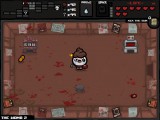
But back to Harpham’s definition of the grotesque: “The grotesque is the opposite, the least ideal form. The circle’s tension is perfectly controlled, but the grotesque is always a civil war of attraction/repulsion”11. Here, Harpham could just as well be describing the relationship between Isaac and his immediate surroundings. The basement that Isaac escapes into is completely devoid of humanism.
In a very different sense, Isaac’s levels are a grotesque rendition of (the dark world of) Zelda. (It is rather curious that Zelda, too, is built on this very dichotomy by itself). Even if there is no mirror world, no better place to return to, its existence is hinted at in a generic, conventional sense. Take the piles of shit, for instance, which clearly in their ludic function fully mimic the shrubbery of Zelda. The same goes for the shopkeeper, the inhabitants of the secret rooms. And so forth; the ideal is always present at the very least in the form of parody.
Harpham also states that “The perception of the grotesque is never a fixed or stable thing, but always a process, a progression”12. As off-putting as the scenery is in the beginning, the landscape becomes - if possible - linearly more repulsive as the player gets closer to the “Womb” levels. Yet the impact of our receiving this imagery in all actuality lessens. With the Binding of Isaac, the progression of the grotesque is actually wholly coherent with the standard pattern of the roguelike.
In a sense, the very first playthrough of The Binding of Isaac has to be the “most” grotesque, due to the shock of recognition: “Is that really a pile of shit I’m seeing?”
Each surprise, each power-up, each newly engaged boss monster is - if not a shock - at the very least a surprise. But like with all roguelikes (and in a way, all games!), playing the game is reliant on our becoming more and more familiar, even comfortable with its grotesqueness. Its rules, its operational modes. The lines of the signifier and the signified begin to blur. What might have been a signal of “gross, a pile of shit” becomes “possibly a coin under the pile of shit”. And cry away at the pile of shit you do.
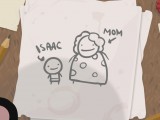
It is through our familiarization with the grotesque that a third form of abjection emerges in playing the game: The stronger Isaac becomes, the more grotesque his shape and form. Harpham continues “…grotesques are marked by such an affinity/antagonism, by the co-presence of the normative, fully formed, “high” or ideal, and the abnormal, unformed, degenerate, “low” or material”11. This applies not only to the location, as I explain above, but also to our image of Isaac.
Isaac, as he is represented throughout the game’s various cutscenes, is an ideal one. Isaac never changes in the imagery; he is constant, a representation of the purity of the child. Within the game’s ludus and diegesis, however, he often becomes a monster more powerful than Mother, more powerful than Satan, even. Does that make Isaac an ultimate of sorts, then? Hardly: Although this ideal state and the concrete state of Isaac’s being are constantly juxtaposed visually, the player hardly ever notices this incongruity, for the abjectional process - and the progression of the grotesque - is so integral to the game’s play.
We don’t even stop to question that Isaac is being transformed into a monster before our very eyes. It seems natural since he is battling the process of external abjection in the game’s ludus as well as narrative - all the while the player grows more and more comfortable with the grotesqueness and uncanniness of it all.
Power-Ups, Meaning and Transformation
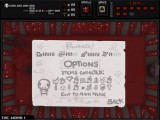
In The Binding of Isaac, players are confronted with a gargantuan (largest predefined array of unique power-ups ever, perhaps, if not counting those generated or randomized on the fly?) amount of equipment, most of which has now been outlined in an extensive wiki. In his selection of power-ups, McMillen strikes a curious balance between items that are congruent either with the religious context of his intertext, or with the more banal, memetic aspects of the game.
Vastly more important than the intertext, or the ways in which the game utilizes it, is rather how the game’s world, its diegesis, can be seen to be the manifestation of the desperate escape fantasies that form in Isaac’s mind during the moments of his distress. This explains the ways in which the banal plane - Isaac’s real existence, being tortured by his insane mother - blends into the fantastic, producing a grotesque combination of the two planes. The grotesqueness of it is obviously enhanced by the fact that we’re dealing with the confabulations of a child in harm’s way.
It’s just that McMillen’s juxtapositions do not strike us as being particularly strange due our inherent familiarity with McMillen’s style, as it sits comfortably at home in our postmodern experience of the online space. After all, we are deeply, almost unsettlingly familiar with outrageous juxtapositions and meaningless mash-ups, in which meaning is only produced by their/our pointing at the very lack of meaning. We are accustomed to things making little to no sense in terms of cohesion or harmony.
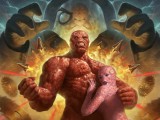
Therefore, a “Shoop da woop” or a “Dr. Fetus” (from the Super Meat Boy game McMillen worked on) power-up is not nearly as out of place in the game as it should. Be it as it may, one could certainly analyse the item catalogue in view of the game’s pseudo-religious theming: “The Bible” item, for instance, transforms the player character into an angel. “Dead Sea Scrolls” spawn random items. “The Necronomicon” damages all enemies. Other marginally related items, such as Ouija boards, and other occult materials also persist.
But vastly more interesting than the actual “powers” of the “ups” is rather how the items work to transform little Isaac’s body, the representational body canvas of the protagonist. The game’s shaky Flash base allows McMillen to transform the player character(s) almost at will with each new item; from a crown of thorns to growing fatter, or from having a bigger head to gaining a third eye, the transformations seem almost endlessly combinatory.
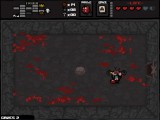
Not nearly all of the aforementioned transformations of the body are beneficial to the player character, either. At the end of nearly every playthrough, successful or not, you will have created a new monster of your own. What is Isaac, at that point, but an abject - cast away in a basement, endlessly changed, transformed, and startlingly inhuman? To put forth the idea in the form of a cliché, Isaac becomes a Frankenstein’s monster.
What is the meaning of all this? A simplistic interpretation is simply to take it as a givens that to fight grotesque injustice, you have to become grotesque yourself. Even empowerment, in the face of a totalitarian abjectifying power, is corruptible, for there is no language but their language, no way but their way, a deeply unsettling and unsatisfying vista.
So, What Is The Binding of Isaac About, or, What Does “The Bible” Do?
In order to truly succeed at The Binding of Isaac, players either need to memorize the effects of each power-up, or be permanently hindered to the point of certain defeat. (Note: Williams also briefly touches upon this.) Isaac’s body must be transformed to meet the emergent challenges both in a particular and systemic sense: By both completing achievements in the game and managing to beat the game’s various bosses, the game begins to spawn more better items with each subsequent replay. Or rather, the game first rewards players for getting better, then later punishes them by ramping up the difficulty.

On its basest ludic level of interaction - the interface of the character to the game world -, then, The Binding of Isaac is about coming to terms with your habitat. Navigating the dangers of both the banal and the ideological. Like other roguelikes, The Binding of Isaac is ultimately about exploration, finding out how things work. What does the Wooden Spoon do? What does the Bible do? What does the Magic Mushroom do? What does Mom’s Underwear do?
In this light, the game becomes a metaphor for the trials and tribulations of childhood and puberty, of growing up, becoming adults and members of society by internalizing rules, patterns and ideologies. That the effects of these power-ups are so viscerally identifiable upon the player character gives an extra incentive for players to memorize the right items to use in the right situations (or use the aforementioned wiki).
All the more curious is the game’s lack of visual congruence. All that players are explicitly told, with “grotesque body horrors”, progressions and transformations, is to not question the ethical or moral repercussions of the various items, but rather judge them solely on the basis of their function. In The Binding of Isaac, you look at the world as a series of trade-offs. Making a pact with Satan? Here are your hearts.
As fans of McMillen’s game will know, the pseudo-religious items have their uses. But so do the occult, the banal, the medical, the outrageous, especially the memetic. For one reason or another, McMillen’s design has resulted in a complete conflation, a flattening of meaning, where each motif of the story on the same level as items. Of course, it can easily be argued that the power-ups flatten into equal value because of their function as power-ups in the game’s ludus. And even then, their price points are different in the game’s various shops.
The Binding of Isaac’s gallery of items is filled to the brim both with symbolic and ludic functions. Even if McMillen intended otherwise, the ludic function almost always overrides whatever symbolic meaning is present; in other words, in the ordinary, rudimentary circumstance of gameplay, function rules all. This results in a kind of absence of meaning that gives to the game a kind of heartfelt subtlety - one that might have been replaced, in a different context, with a violent bombast instead. In any case, one fact remains: Before you have memorized the transformative power of an object, everything in the game is on the level. A Dead Cat is juxtaposed to a Small Rock is juxtaposed to The Book of Revelations.
Isaac and Catholicism
Last and very much least, I want to quickly discuss the portion of Williams’ article wherein he discusses McMillen’s portrayal of Catholicism. He astutely remarks that
Catholicism has frequently been much less terrified of the body … Consider the embrace of the physically grotesque as an expression of her own theology in the writings of Flannery O’Connor, for example.1
 He also says that “McMillen’s vision of evil and the body being almost inextricably linked almost feels more like American Puritanism than Catholicism.“1 This is true, even if Williams conveniently omits that Catholicism to this day - in the form of the much-maligned, Dan Brown -sensationalized Opus Dei, for instance - is in fact still obsessed with abusing and controlling the body and its functions. As long as the Pope is anti-contraception, and Roman Catholic priests sworn to celibacy, that particular discussion is a done dada.
He also says that “McMillen’s vision of evil and the body being almost inextricably linked almost feels more like American Puritanism than Catholicism.“1 This is true, even if Williams conveniently omits that Catholicism to this day - in the form of the much-maligned, Dan Brown -sensationalized Opus Dei, for instance - is in fact still obsessed with abusing and controlling the body and its functions. As long as the Pope is anti-contraception, and Roman Catholic priests sworn to celibacy, that particular discussion is a done dada.
Therefore, I find there to be a kind of unwillingness, on Williams’ part, to ask the right question. We should ask not, “How is McMillen’s game influenced by Catholic grotesque?” but rather, “How can religion be so grotesque”?
Surely the game takes part in the latter discussion rather than the former? Surely The Binding of Isaac is not only a “reflection of” but also a “response to”? Again, when Williams states that “pietas and crucifixes place the emphasis on a body broken for adherents to the faith, unlike the more abstracted, empty cross of Protestantism”1, this kind of fetishization of bodily harm and physical suffering - or like both in the case of Jesus and Isaac, the killing of your own son - would be exactly the kind of thing that McMillen would be discussing and reacting to with his game, right?
That Williams manages to see The Binding of Isaac as a reflection of the “shame and terrors evoked by the body”, yet refuses to explicitly acknowledge religion’s role in it is a little troubling. Recall Kristeva’s remark of “dietary prohibitions”, for instance. Again, Lent. Purity rings. One could just as easily cite phrase upon phrase from Leviticus to bring into focus the idea of menstruation as unnatural, or cite Deuteronomy as reminder of the dangers of shrimp. Or simply bring up the tradition of male circumcision - indeed a “grotesque body horror” - still an overwhelmingly prevalent practice in the United States.
But in many ways critiquing Williams over that would already be beside the point. Still, I do find that not portraying The Binding of Isaac as anti-Abrahamic would be intellectually dishonest. But at the same time, to pretend that religion is the only thing that makes the game tick would be equally dishonest: Even if the game’s ludic functions in fact do reign supreme over the symbolic, it shouldn’t discourage us from trying to reach and poke at the symbolic level - even if analysing the game’s thematics almost certainly results in an untenable interpretation simply because of the chaotic thematic make-up of the game. But that’s McMillen for you.
Insofar as it pertains to its generic make-up, however, The Binding of Isaac is in fact relatively, even surprisingly coherent. This is perhaps the gist of my overall argument. As I’ve tried to illustrate in my article, carnivalesque, at its heart, functions to overthrow the establishment - even if just for one day. Grotesque, though already cast away from the establishment, exists solely to creep back in as body horror. Finally, abjection moves us into uncanny social and ethical territory.
Again, my utmost thanks to G. Christoper Williams for opening up the discussion. You can read more articles by Williams over at his blog, Banana Pepper Martinis, as well as at the excellent PopMatters. Thanks for reading!
- http://www.popmatters.com/pm/post/154501-fearing-god-fearing-the-body-the-theology-of-the-binding-of-isaac/ [↩] [↩] [↩] [↩] [↩] [↩]
- Cambell in Creed, Barbara 1986: ““Horror and the Monstrous-Feminine: An Imaginary Abjection”, 44 [↩]
- Creed 1986, 49 [↩]
- Creed 1986, 47 [↩] [↩]
- Freud, Sigmund 1919: “The ‘Uncanny’”, 123-124. Trans. Alix Strachey [↩]
- Harpham, Geoffrey G. 1982: On the Grotesque, 3 [↩]
- Kierkegaard, Søren 1941/1843: Fear and Loathing. Trans. Walter Lowrie, 60 [↩]
- Kierkegaard 1941, 60 [↩]
- Kierkegaard 1941, 86 [↩]
- Kierkegaard 1941, 87 [↩] [↩]
- Harpham 1982, 11 [↩] [↩]
- Harpham 1982, 17 [↩]

Very interesting, it’s really interesting to read an engagement with games that brings in literary theory, I really enjoyed that. If you will permit me some small criticisms though: it does seem a little disparate to bring in theorists as varied as Bahktin and Kristeva in to the same argument - indeed, that Bahktin is misspelt in the article does suggest that not as much thought has been put in to that area as others. Also I’m also think final section on religion is much more problematic than this essay allows for. I am not a ‘religious’ person myself, but it seems sweeping to broadly categorise the whole of ‘religion’ as ‘so grotesque’ when even just Catholicism alone is an unfathomably vast, varied and internally conflicted blob of ideology. Although Dan Brown may influence popular perceptions of Catholicism, his work in itself can definitely not be taken as evidence of Catholics being obsessed with something, Brown is not a Catholic and even if he were his books are entirely focused on obscure periphery (if not invented) parts of Catholicism. BUT on the whole it was fantastic to read something so intellectually stimulating about videogames, thank you!
My own grammar errors in a small paragraph comment also far outweigh the tiny typo that I criticised hahah.
Thanks for your thought-out comment. I’ll take your criticisms to heart later, and I do agree with the overall sentiment that many of the ideas here are underdeveloped. The luxury of time awards to us the luxury of knowledge… and… the former’s absence leads to the latter’s, etcetera
Do let me however be super-quick to point out the most ostensibly damning critique of them all - as you know, there are several standards for romanizing Russian, and by extension, the same conundrum indeed applies to Mr. Mihail/Mikhail Bahtin/Bakhtin.
The final section, as strawman-like as it is, exists to counter-balance Mr. Williams’ take, which, again, politely bowed out of the question altogether.
Again, I’m extremely pleased that you found the article to be worthy of critique, and indeed, I’m already regretting that I’d not put even more into time into what was absolutely a large-scale project for a mere blog post.
A further amendment to the article that springs to mind from hexagonalbolt’s comment - although I’m personally interested in the narratological aspects of games (and hope to get there in my games writing at some point in the future), this particular post couldn’t be much further away from my area of expertise as it pertains to any of the topics - Roguelikes, ethics and religion, representation, genre…
It’s just that The Binding of Isaac is pretty darn interesting, like Williams’ articles already proficiently illustrate over at PopMatters, so you’re simply drawn in to toy and experiment.
Haha, owned! Again, I’m sorry, I didn’t mean my comment to be such a wall of criticism, I really enjoyed the article! Any attempt at tackling such a huge subject and undertaking such close analysis is commendable.
In case you hadn’t noticed I was drawn to this page by a link from an RPS link to it, there’s a discussion in the comments there about literary theory with videogames. http://www.rockpapershotgun.com/2012/03/04/the-sunday-papers-208/
I’m so glad that your analysis exists, even if I’m not sure if it’s the most fun way to talk about video games. :-)
Also… I swear there is a book I read a few years ago with similar character’s to TBoI (a mother and daughter, maybe jehovah’s witnesses?), but I can’t think of what it was.